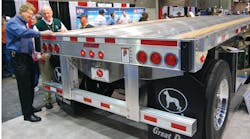Latest from Archive
Navistar on Thursday launched the eStar, the first purpose-built, all-electric delivery vehicle, which Navistar is deploying with the help of a $39 million grant in American Recovery and Reinvestment Act funds from the Transportation Electrification Initiative administered by the U.S. Department of Energy.
FedEx will receive the first full-production eStar. Navistar is currently taking orders for the eStar and expects to build 400 trucks at its facility in Elkhart, Ind., by the end of 2010, with production reaching several thousand vehicles within a few years as the market grows. Shane Terblanche, GM of Navistar’s electric vehicle program, said the company expects to ramp up production to 4500 units a year within five years.
The eStar is the first medium-duty commercial vehicle to receive U.S. Environmental Protection Agency (EPA) certification as a clean fuel fleet vehicle as well as California Air Resources Board (CARB) certification as a zero-emissions vehicle. With zero tailpipe emissions, each eStar truck can reduce greenhouse gas emissions by as much as 10 tons annually. (See a photo of the e-Star in the last side of the Mid-America Trucking Show 2010 gallery.)
This Class 2c-3 electric truck—the first in its category—can travel about 100 miles before requiring a recharge. Intended primarily for fleets and commercial truck users in congested, urban environments where stop-and-go driving would otherwise consume a large amount of fuel, the vehicle has been successfully tested to 200,000 miles.
Its narrow and nimble size makes it perfect for city work and increases driver safety. It has a a 36-foot turning diameter that helps navigate small spaces, a 4,000-pound payload capacity that delivers a wide range of products, a nearly 180-degree view from the cab and low 25.6" load step height.
The 220 volt split-phase electrical charging process is quick and efficient. When the work day is over, the eStar recharges overnight in approximately eight hours. It has a quick-change cassette-type battery that can be swapped out in 20 minutes, enabling around-the-clock operation.
Unlike other electric trucks that are reconfigured models of fossil-fuel trucks, the eStar truck has been purpose-built for electric power, creating an advantage with a low center of gravity (the battery is between the frame rails, not mounted on top) and turning radius. The eStar is engineered with superior aerodynamics, and a walk-through cab. There is one standard chassis with two body lengths: 14’ and 16’. Terblanche said it will launch as a cargo van with an integrated cargo body for the first year of production, and then Navistar will “investigate the opportunity to deliver utility bodies or drop sides, but that will take further development.”
He said Navistar has 900 dealer locations and will select dealers throughout the country based on deployment plans. It initially will be deployed in three geographically diverse areas: the Pacific Northwest (Seattle), West Coast (Los Angeles and Sacramento) and Midwest (Chicago and Indianapolis).
“We will select dealers based on best-in-class performance, looking at the demand for vehicles in a specific area as well as the ability of the dealer to serve that particular region,” he said.
FedEx showcased a prototype of the eStar electric truck during last month’s “Charge Up Route 66” tour that began in Chicago and ended in Los Angeles as part of the Fortune Brainstorm Green Conference. FedEx will evaluate the performance of the eStar vehicle in its fleet as it operates four trucks in the Los Angeles area.
“These vehicles allow us to have an 8-hour shift of deliveries,” said media relations director Deborah Willing. “They’re working fantastic for the Los Angeles area because they have dense urban routes which have the opportunity for energy to blow back into the battery, lots of starting and stopping, works well with mileage and is an exciting opportunity to add something that is zero-emissions, zero-tailpipe into the Los Angeles market.
“We took a prototype on Route 66, and we got fantastic interest. It’s really an interesting-looking vehicle. In one small town in Missouri, a reporter was tipped off and chased our vehicle down. Our team members have loved driving it. It’s very smooth and quiet, so we’re very excited to be adding these to our fleet.
“We’re working to improve our fuel efficiency by 20% by 2020. There’s great environmental potential and huge potential for getting off foreign oil.”
Dave Meisel, transportation director for Pacific Gas & Electric said his company is not yet ready to commit to using a fleet of eStars, but he said PG&E has one of the largest fleets in the country and is a strong advocate of electric efforts.
“The operational efficiencies ideally are fuel savings,” he said. “But in the utility industry, where we spend a significant amount of time driving a vehicle, we also spend a lot of time on the work site, where we have to utilize tools or aerial beams. Fuel savings through engine-off operations is an amazing opportunity in this industry. It is fuel consumption with no miles driven. If we can take the drive portion and make that petroleum-free and if we can go to electrifying the work site, that makes it even better.
“It presents a nice opportunity in the area of extending our work day. Noise restrictions in major metropolitan areas impact a utility. When we have to take a standard diesel vehicle into large cities like San Francisco, where roads are close and older cities where residential communities are on top of commercial, that forces us into areas that have noise restrictions. Many times we have to stop working at 7 or 8 at night because of noise emissions. This would give us an opportunity to improve that.”
The all-electric delivery truck is the latest of Navistar’s green-vehicle solutions and endeavors. In January 2010, the DOE selected Navistar to serve as its partner for the SuperTruck, a program to improve the efficiency of on-highway trucks by 50 percent. The company was also the first in the nation to develop diesel-electric hybrid school buses and plug-in hybrid school buses, and the first to enter assembly-line production of diesel-electric hybrid commercial trucks.
The collaboration between Navistar and DOE exemplifies business and government working together to make energy efficient vehicles a reality. Congressional support for further research and development of advanced vehicle technologies is critical. In fall 2009, the U.S. House of Representatives passed legislation providing for a DOE program to fund the research, development and commercial application of clean-vehicle technologies (H.R. 3246, Advanced Vehicle Technology Act of 2009). The bill is now under consideration in the Senate.








